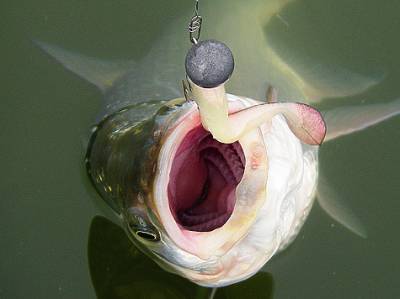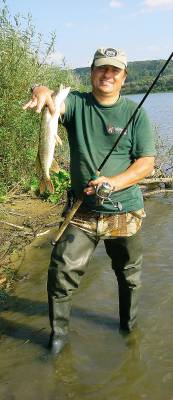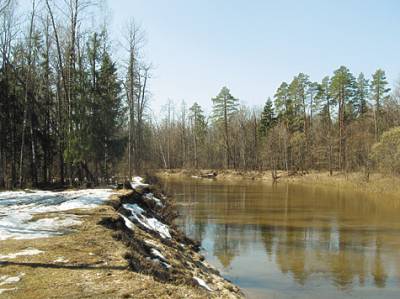
Sometimes years, from the opening of the season, spinning, fishing with artificial lures on river flow has a certain difficulty. This is due to the fact that on rivers with vigorous stirring of water no thermal stratification, as, for example, in reservoirs. So, first of all, the difficult search for a specific predator.
In the summer, in the conditions of same temperature of water in the river, a predator can in a day of fishing to be anywhere and be either in active or in passive state. But it is still and weather, and fluctuations in the level and strength of currents, and food availability in a particular area, and the rise of vegetation, and even the wind direction.
But, as experience shows, all summer warm river of water, many predators still gravitate to the coastal zone, and choose those areas where the bottom near the shore is firm, not muddy, and the flow increased. Probably, here the wave does not wash away decaying organic deposits that do not lead to deterioration of water quality, and vortex flow contributes to a better saturation of the aquatic environment with oxygen from the air.
Especially the clear commitment to the river rapids in different fish becomes during periods of prolonged heat. Then boiling over in one place spinning can take rapid and Chub, and Chub, and a lover of deep holes in the perch, and a resident of the coastal thickets of pike, and the ubiquitous perch, and even catfish are slow. And only prolonged bad weather with heavy rains, elevation and turbidity of water can make some time to get away and predators, and their potential food in quieter places on the river.
SPINNERS AND WOBBLERS
Species of fish that angler strives purposefully to catch in the strong current of a summer river, largely defined as a choice bait, and the technique of its transactions, as well as distance catching. If in water to throw any tucked under the arm imitation and “drag” it in an arbitrary manner, without regard for the fact that she is under water, it usually leads to a zero result, but the fish can be caught only by chance.
So to “get” chubs or Chub from a far distance, the most appropriate special spoon lures type of kastmaster or Pilcher, and different “turbines”, “Devon” and tube baits gradually fell out of use because they spin much used now the thinnest braided line. She does not have the rigidity as nylon monofilament, and bad resists twisting, which is not save and the best quality wartlike, and even combined with the lure protivosokowoe. However, and weighted turntables good “catch” from a distance, but preference should be given only to those who have a core with a displaced center of gravity, virtually eliminating the twisting braids.
But the hunt for a predator in the coastal channel, with a strong current, which usually feed on the walleye, pike and perch, most successful when applied under specially selected conditions of fishing lures that consistently play in an unstable flow. And fishing here, as a rule, is short-circuited, without shots — it’s easier to control the flow of the bait, which sometimes can visibly be observed in the polarization glasses. As experience shows, a strong current better than the other imitations are floating vane cranks “crank” with a short, thick body and heavy without paddles “ratline” that play through beveled the frontal part and fixing the fishing line to the “back” of the lure.
And if “KranK” pick with a certain tilt of the blade, which determines the depth of stroke to avoid hooks at the bottom, then fast sinking “ratline” is irrelevant — it’s about the weight of the lure and speed the transaction. Thus, when reaching the “head” down “rattlin” hits the bottom, then they do not cling to him, but reflected upward, raising a cloud of Muti, well what provokes different predators to take.
But as for floating “kranke” and fast sinking “rattlin” very important given the strength of the flow to pick up the speed and direction of the transaction. It is necessary to first went as slowly as possible and as close to the bottom, and the second “hit” on the bottom, not “uticas” in it, and only strikes it at certain intervals, simulating the behavior of small benthic fish. Typically, as with spinners and lures bulk fishing on a fast river is a slow posting “the demolition”. With this technique, the bait is thrown across, or some angle downstream, and then, judging by her “work”, well transmitted to the sensitive rod is conducted with a particular speed until the fishing line stretched along the shore.
Bites can occur throughout the transaction, but for some reason the most faithful grasp happen in a brief moment of complete movement for demolition when the bait is fixed in place before moving along the coast. And here I must say that the predator is, apparently, the lure until he notices and chases, maybe even from afar, because trying to catch, making casts directly into the area of biting any result did not give.

Especially the clear commitment to the river rapids in different fish becomes during periods of prolonged heat.
Then, to implement such a scheme catching with maximum effect, it is necessary, apart from using lightweight lures, to apply the long, up to three meters, hard rod or at least “stick” with classical parabolic systems. The spinning not only feels good all touch the bait at the bottom, but and light “kicks” the accompanying imitation of a fish, which subsequently can deliberately adjust the speed and depth of the wiring position of the tip of the rod and work the reel to cause the predator to correct the grip.
But the recommendations to choose the mechanical spinning only the weight of the bait in strong currents almost unnecessary, since the pressure of the flow on the line and the lure, this weight increases dramatically. For this reason, all the “lights” and “ultralight” for simply flexes “in the arc”, and the wiring on demolition, especially on the last stage, becomes unreadable and unmanageable, and even a decent size fish to take more feeble “sticks” very hard and long time.
BYPASS LEASH
Also a very interesting and profitable way of fishing on a strong current at low depth is the use of snap-in retractable leash — there certainly requires long and hard “jig” rod with a fast action that dictated the total weight of the tooling, and the type of transaction that is close to speed. Here the installation of a split shot and bait as follows. At the end of the fishing line using the handy clasps set spherical or pear-shaped sinker, the weight of which is typically in the range of 10-50 grams, that can have power flow and casting distance, but also partly by the activity of the fish, when the “jig” steps of a split shot on the bottom is required to combine with the elements of fishing “on demolition”. If the throw required is extremely long, with a heavy sinker, to the main fishing line-braided line initially binds stronger shock leader up to three meters, and its end is the lead.
Since this a purely bottom fishing, the lures are usually quite compact twisters, shads, plastic worms, and improvised imitations from foam rubber, polyurethane foam or the famous classic streamers. All these lures are equipped with double or triple crochet optimum size, and one or two offset hooks, if there is a threat of frequent “dead” rocks. When active pike in the heat often enters the rapids, the bait definitely are complemented by a soft metal leash length of 30 centimeters.

FOR FAST-FLOWING RIVERS.
A set of spinning lures for fishing in strong current is usually very wide. It largely depends on the fishing conditions on a particular stretch of the river, and on fish species, and from the current season. For example, in the heat of such an active “white” predators, Chub and ASP, in which warm water is better bite on spinners, but on the background of cooling of water in autumn, they often manage to lure sluggish playing “kastmaster”, weighted streamer or lure type-bellied Bumpkin “kranke”. In the same circumstances benthic predator Zander, who loves to think on the course in places with a rocky bottom, takes excellent optimally immersed jig lure — foam-rubber fish, twisters, shads, if bottom posting for the demolition of an elongated “step”.
Then the crucial moment, which determines whether this snap-in “catch”. It features a main leash and its position relative balance. As shown by long-term practice, do not get involved with the thin leads, and make their wicker — she’s too soft. For this purpose it is better to use the hard nylon line with a minimum thickness of 0.25 mm — then she will behave in a predictable flow, not to curl in itself and not to obkruchivajutsja randomly around the main line, cannot stop and wartlike. The practice of fishing complements — the length of the leash must be no less than a meter, and better — 1,20−1,40 meter. Leash through a triple barrel or just a way to “loop the loop” is mounted about 20-30 cm above the weight, however, there are no contraindications, so as not to snap it right behind the ear or sinkers fastened here by means of a fastener that will allow it to quickly replace. And in this case, the snap-on for working efficiently, unlike fishing in stagnant water, when the leash is better to put at a distance from the sinkers.
Fishing techniques retractable leash, above all, starts with the cast, which is run not so easy, given the “Suisse” snap length of about 1.5 m below the tip of the spinning. And it requires long hard rod, and also sufficient free space behind you. Snap-bitingly is sent to the desired distance across the stream or at some angle to it. When the tip of the spinning “work out” the sinker touch the bottom, is a high-speed retrieve fishing line by up to three meters, followed by a pause, is approximately equal to the time during which the leash with the bait out when the PREROLL along the main line, will fully unfold. After that, the cycle repeats, with a heavy sinker might not “work out” the bottom and just drag on him.
The grasp of a predator in the form of sensitive “jab” often comes on the pause, if the wiper arm moves in a short arc “on demolition” and the lure actively playing. But often the fish felt the hook in the form of a sudden gravity at the beginning of the next winding, then be sure to make a trip to the trophy, barely hooked, it isn’t. It should be added that retractable leash on a strong current it was possible to catch not only “notebook” bottom predators, such as walleye, Bursch, pike and perch, but also ASP, Chub, IDE and even sabrefish, bream, white bream and Rudd. Here, much depended on the size and type of bait, and chosen method of animation. The “non-predatory” fish bite most aggressively, when I managed to get into her tight flock.








